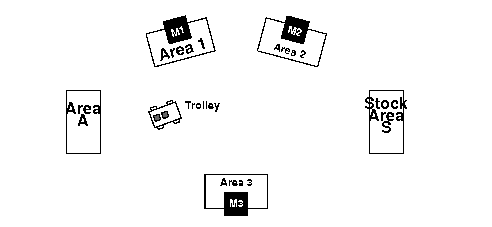Describing the Problem
 PREVIOUS
NEXT
PREVIOUS
NEXT
| IBM ILOG Scheduler User's Manual > Advanced Concepts > Scheduling with State Resources: the Trolley Problem > Describing the Problem |
Describing the Problem |
INDEX
 PREVIOUS
NEXT
PREVIOUS
NEXT
|
The problem described in this chapter consists of n jobs to be performed in a shop equipped with m machines. A job corresponds to the processing of an item. Each item needs to be sequentially processed on k specified machines with known processing times.
In the problem, we want to model the physical distance between machines. The items to be processed are initially available in area A of the shop. Each time an item must be processed on a machine M, it must be brought to the area of this machine with a trolley. After the item has been processed, it must be stocked in area S of the shop.
Moving an item from an area x to an area y means (1) loading the item on the trolley at area x, (2) moving the trolley from area x to area y and, finally, (3) unloading the item at area y. We suppose that the activities of loading (and unloading) items can overlap, assuming that the trolley is in the same area as the items. We search for a solution that minimizes the makespan of the schedule.
In the first version of the problem, we do not consider the time taken by the trolley to go from one area to another. We suppose that there is only one trolley shared by all the jobs and that this trolley has no limit on the number of items it can carry. We want to solve an instance of the problem with six jobs and three machines (M1, M2, and M3) as shown in Figure 23.1. Each item requires processing on two machines. There are five areas in the shop (A, M1, M2, M3, and S) and each job consists of the following eight activities:

The following C++ arrays provide the data defining the problem. The ith column of arrays JobNames, Machines1, Durations1, Machines2 and Durations2 respectively define: the name of the ith job, the number j of its first machine Mj, the processing time on this machine, the number k of its second machine Mk, and the processing time on this machine.
Two additional parameters are defined: the duration of loading (and unloading) activities and the number of jobs in the problem.
These parameters are passed to the function DefineModel. This function returns an instance of the class IloModel that corresponds to the problem and sets the constrained variable makespan to be minimized. This function also stores an array of jobs (Job*) that is used later to print the schedule.
| © Copyright IBM Corp. 1987, 2009. Legal terms. | PREVIOUS NEXT |